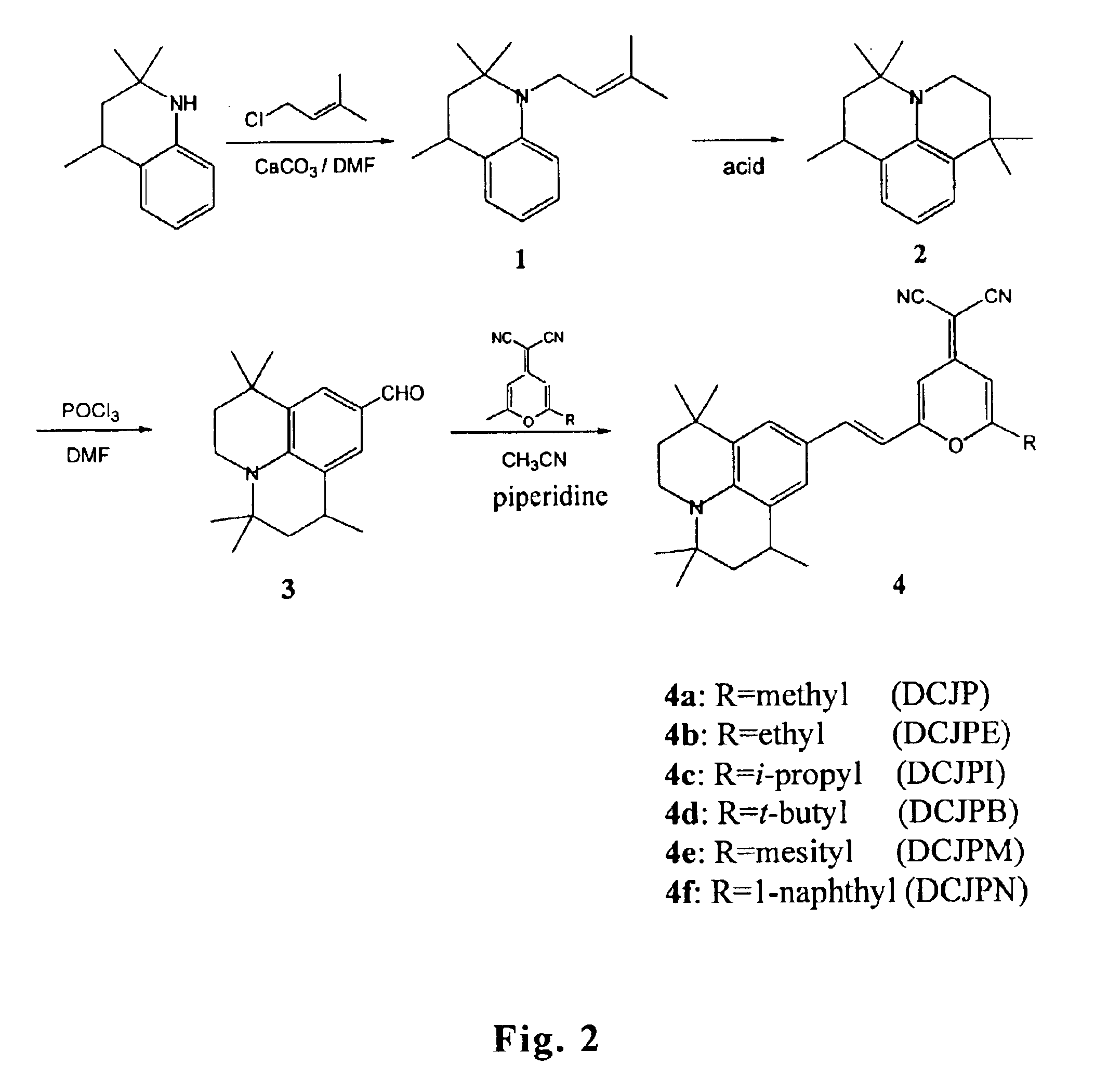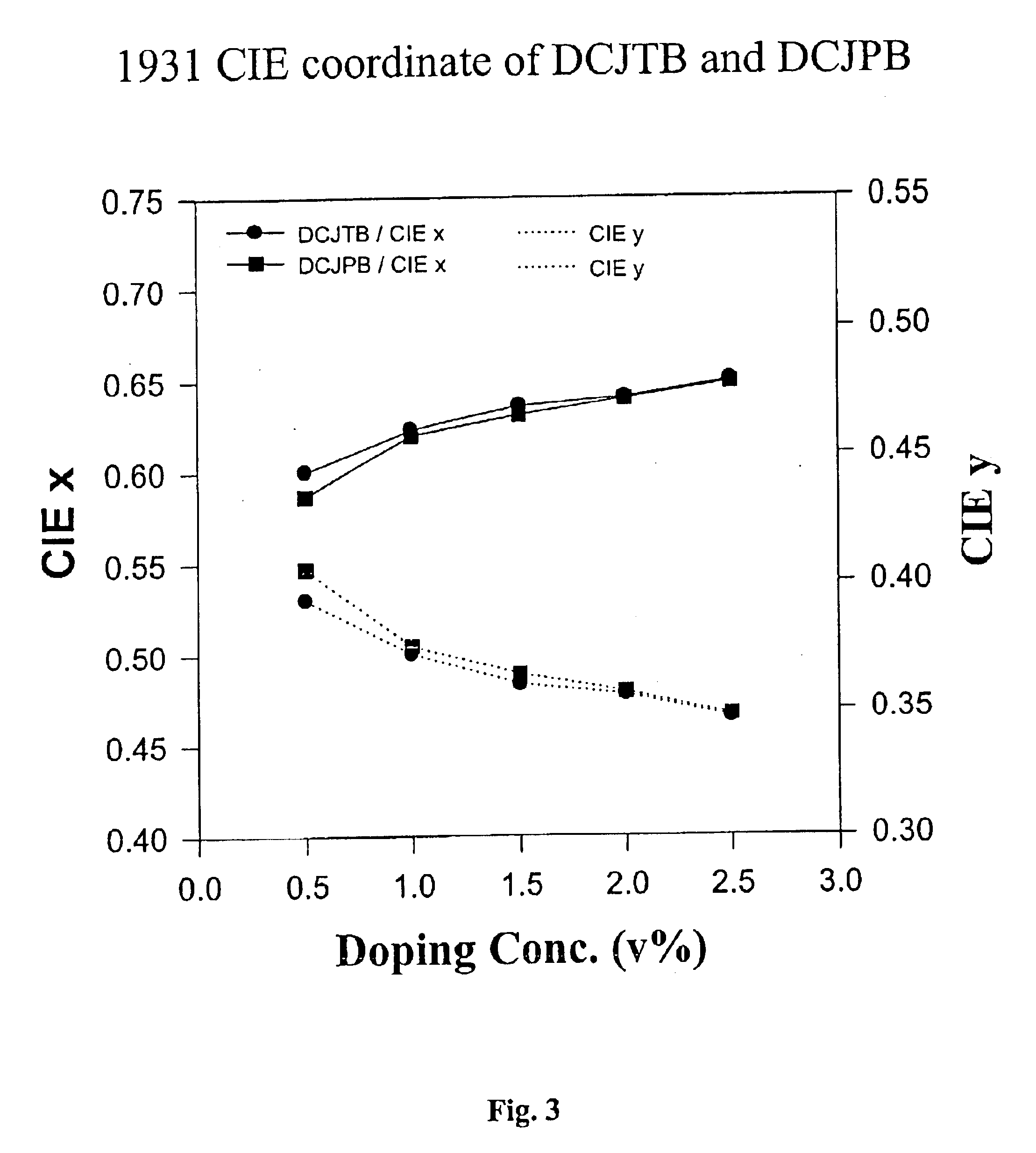Efficient organic electroluminescent devices with red fluorescent dopants
a technology of fluorescent dopants and organic electroluminescent devices, which is applied in the direction of discharge tube luminescnet screens, natural mineral layered products, etc., can solve the problems of high resistance of the medium, the problem of most problematic research for a primary red light, and the operation of the el device requires a relatively high voltage (>100 volts) to achieve the effect of improving luminous efficiency and chromaticity
- Summary
- Abstract
- Description
- Claims
- Application Information
AI Technical Summary
Benefits of technology
Problems solved by technology
Method used
Image
Examples
example 1
Synthesis of Compound 4a (DCJP)
Synthesis of Compound 1
23.5 g of 1-chloro-3-methyl-butene and 28 g of calcium carbonate was added to a solution of 28 g of 2,2,4-trimethyl-1,2,3,4-tetrahydroquinoline (the detailed synthesis of 2,2,4-trimethyl-1,2,3,4-tetrahydroquinoline can be found in U.S. Pat. No. 3,247,211) in 200 mL of DMF. The reaction mixture was stirred at room temperature for 3 hours. The reaction mixture was then extracted with diethyl ether and water. The organic layer obtained was dried over MgSO4, concentrated and purified by chromatography using ethyl acetate / hexane (1 / 8) as the eluent to give 36.7 g of brown liquid. Yield: 94%.
Synthesis of Compound 2
A solution of 25 g of compound 1 in 200 mL of concentrated sulfuric acid was stirred at room temperature for 4 hours. The mixture was poured onto pieces of ice, neutralized with an ammonium hydroxide aqueous solution and then extracted with diethyl ether. The organic layer obtained was dried over MgSO4, concentrated and purif...
example 2
Synthesis of Compound 4b (DCJPE)
A solution containing 20 g of compound 3, 0.1 g of piperidine, 13.7 g of 2-(2-ethyl-6-methyl-4H-4-pyranyliden) malononitrile and 250 mL of acetonitrile was stirred at 45° C. for 4 hours. The mixture was diluted with water and then extracted with diethyl ether. The organic layer obtained was dried over MgSO4, concentrated and purified by passing through a silica gel column using ethyl acetate / hexane (1 / 7) as the eluent to give 25.9 g of red solid. Yield: 80%. Mp: 276° C.
example 3
Synthesis of Compound 4c (DCJPI)
A solution containing 18.5 g of compound 3, 0.1 g of piperidine, 13.6 g of 2-(2-isopropyl-6-methyl-4H-4-pyranyliden) malononitrile (the synthesis procedure was reported by Chen et al. Thin Solid Films 363, 327, 2000) and 250 mL of acetonitrile was stirred at 45° C. for 5 hours. The mixture was diluted with water and then extracted with diethyl ether. The organic layer obtained was dried over MgSO4, concentrated and purified by passing through a silica gel column using ethyl acetate / hexane (1 / 7) as the eluent to give 25.9 g of red solid. Yield: 84%. Mp: 269° C.
PUM
| Property | Measurement | Unit |
|---|---|---|
| Nanoscale particle size | aaaaa | aaaaa |
| Nanoscale particle size | aaaaa | aaaaa |
| Nanoscale particle size | aaaaa | aaaaa |
Abstract
Description
Claims
Application Information
 Login to View More
Login to View More - R&D
- Intellectual Property
- Life Sciences
- Materials
- Tech Scout
- Unparalleled Data Quality
- Higher Quality Content
- 60% Fewer Hallucinations
Browse by: Latest US Patents, China's latest patents, Technical Efficacy Thesaurus, Application Domain, Technology Topic, Popular Technical Reports.
© 2025 PatSnap. All rights reserved.Legal|Privacy policy|Modern Slavery Act Transparency Statement|Sitemap|About US| Contact US: help@patsnap.com



